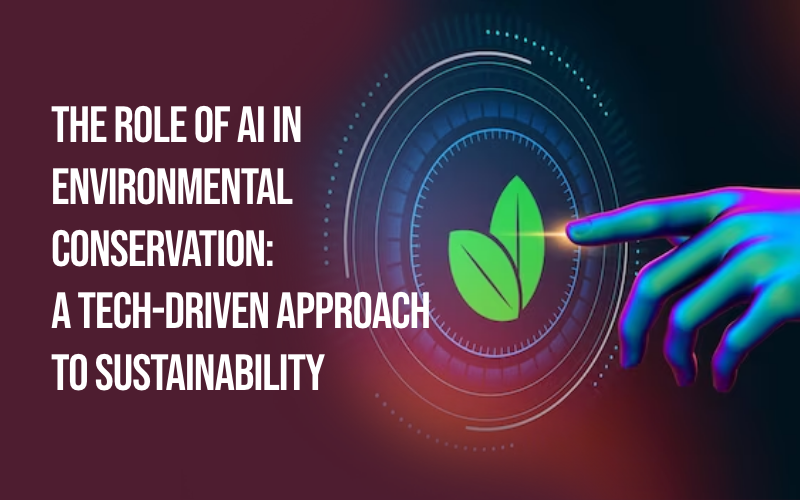In recent years, environmental issues have triggered debates, awareness programs, and discussions that have further encouraged interest in new technologies such as artificial intelligence.
AI finds applications in a wide array of environmental sectors, including wildlife protection, natural resource conservation, waste management, clean energy, pollution control, and agriculture. Various firms are also collaborating with an AI development company that particularly addresses environmental challenges and helps in steering towards a sustainable future.
The role of AI in environmental conservation is multifaceted and impactful. From monitoring the intricate dynamics of our ecosystems to protecting endangered wildlife, technology is transforming our capacity to address complex ecological issues.
In this blog, we will further explore AI solutions for environmental conservation that transcend human capacity and help in reshaping the future of our planet.
AI in Environmental Conservation: What Does it Mean?
Artificial intelligence has been playing a crucial role in environmental conservation by offering unique solutions to address various challenges related to climate change, and natural resource management.
One of the most significant contributions of AI is its ability to process and analyze vast amounts of environmental data quickly and accurately. AI is also instrumental in optimizing resource management and sustainability practices.
Furthermore, AI is also aiding in the development of smart cities and sustainable urban planning. By analyzing the data from various sources, including sensors and IoT devices, artificial intelligence has the ability to optimize energy usage, reduce pollution, and enhance overall resource efficiency in urban environments.
As AI technology continues to advance, AI holds great potential to contribute significantly to global efforts aimed at preserving and protecting the environment.
What is the Role of AI in Environmental Conservation?
Artificial intelligence technology is altering our approach to conserving the environment and the way countries perceive complex ecological issues.
Protecting Wildlife with AI
AI has proven to be extremely beneficial in wildlife conservation. AI-driven camera traps and acoustic monitoring systems automatically identify and track animals, further helping the researchers to study behavior, population dynamics, and migration patterns.
AI for Environmental Monitoring and Analysis
The role of AI in environmental conservation is multifaceted, and one of its primary applications is in environmental analysis and monitoring. Remote sensing technologies, such as drones and satellites, equipped with AI-driven algorithms, enable scientists and conservationists to collect vast amounts of data on ecosystems, wildlife behavior, and climate patterns.
AI for Climate Change Mitigation
AI contributes to climate change mitigation through a range of applications. ML models process climate data to enhance the accuracy of climate predictions, further helping scientists to better understand the dynamics of global climate systems. AI also plays a role in energy efficiency and emissions reduction.
AI in Sustainable Transportation
Transportation is a major contributor to greenhouse gas emissions. AI is promoting sustainability in transportation through the development of electric and autonomous vehicles. Autonomous vehicles, when integrated into shared transportation systems, have the potential to reduce fuel consumption, traffic congestion, and emissions.
Benefits of Integrating AI into Environmental Conservation
There are several benefits of integrating artificial intelligence into environmental conservation. Some of them are:
- Improving Climate Prediction and Monitoring
Advanced AI algorithms are capable of analyzing vast amounts of climate data, historical patterns, and real-time information to improve weather forecasting accuracy. The technology helps scientists and policymakers understand the effects of climate change, making more accurate predictions about extreme weather conditions and formulating strategies to mitigate the impact.
- Helps in Enhancing Energy Efficiency
AI also helps in enhancing energy efficiency and reducing carbon footprints. Smart grid systems powered by AI algorithms can optimize energy distribution, predict demand, and manage load balancing effectively. By embracing such AI capabilities, it is quite clear that more sustainable and resource-efficient energy systems can be achieved much more easily.
- Facilitates Optimization of Waste Management Practices
There is no doubt that effective waste management is critical for a sustainable future. Apart from promoting sustainable waste management practices, AI is also employed in waste sorting facilities, where robotic systems equipped with computer vision technology can identify and sort different types of waste to minimize their environmental impact.
- Preserving Biodiversity and Protecting Endangered Species
The use of artificial intelligence in conservation and biodiversity efforts has proven to be instrumental. AI-powered tools are also able to analyze complex data sets, such as camera trap images or acoustic recordings to identify and track animal populations, contributing to more effective conservation strategies.
Final Words
The role of artificial intelligence and technology in environmental conservation is continuously expanding. As we face ever-increasing environmental challenges, AI tools are essential for mitigating, monitoring, and managing the threats to our planet.
By efficiently collecting and analyzing the data, supporting wildlife conservation efforts, optimizing resource management, and mitigating climate change, AI and technology have become indispensable in the fight for a greener and more sustainable future.
As AI is only set to develop more advanced in the future, its potential to revolutionize environmental sustainability and combat climate change remains immense, offering hope for a brighter and more environmentally conscious future.
Read More: 5 Frontend Web Development Tools To Boost Productivity

